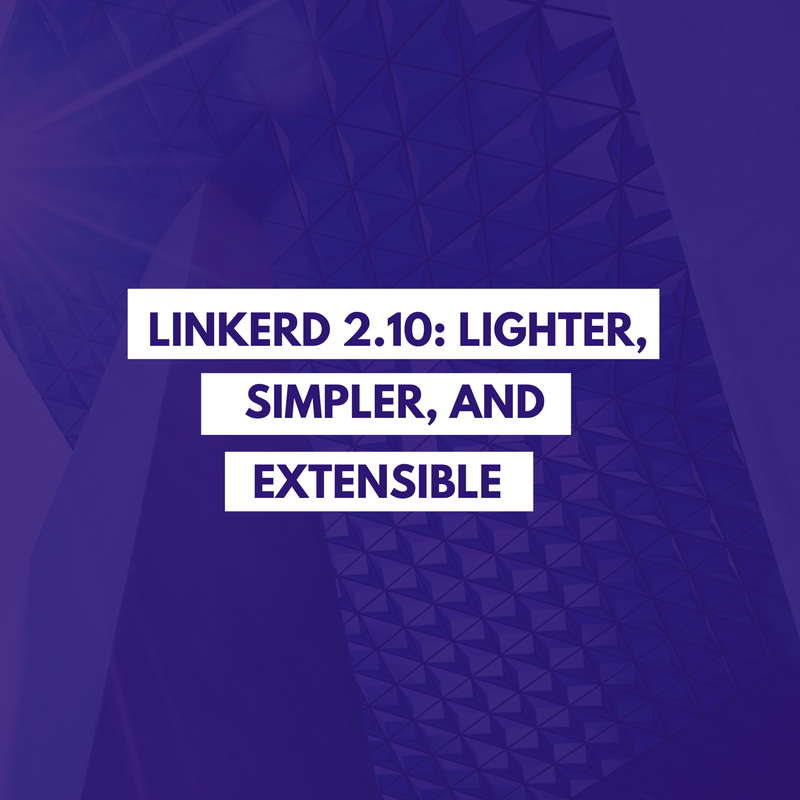Linkerd 2.10: Lighter, Simpler, and Extensible
Platform extension came with attractive components that further quell the turbulence with Kubernetes deployments.
TL;DR
Linkerd 2.1 is the latest release of Buoyant's open-source service mesh project for Kubernetes. It further expresses the tech giant's devotion to building a portable, composed service mesh in the existing ecosystem to ease the complexity of Kubernetes.

Key Facts
Linkerd now can provide metrics at the route level, not just the service level.
The Linkerd Steering Committee has been launched squarely to promote open governance.
The newest version is configured to enable extensions to the platform.
Another highlight is multiple component options for cluster creation.
Details
This service mesh maintains its reputation as the lightest and fastest of the pack. Linkerd 2.1 speaks more volumes of these standards.
The service mesh architecture enables the IT team to scale through complex structures through components called sidecar proxies. It has amassed traction recently among Kubernetes and microservices users, majorly because it boasts detailed scrutiny and security for connections between distributed projects.
Thanks to the addition of metrics at route level, Linkerd can now reveal slight or massive changes like failures, slowdowns, or traffic level infringement to a particular API call in a service.
They are built on service profiles, a lightweight avenue of providing information on an extension to Linkerd.
Linkerd, of course, isn't the first open-source service mesh project to have a steering committee. A list of projects in the cloud-native field has enforced steering committees which turned out a success. But the Linkerd steering committee is reasonably different from the others. Since the vision is to meet the needs of innovative startups, existing companies, and future users, the steering committee encompasses Linkerd users. Committee members are teeing up with maintainers to ensure the project is always on point with Linkerd's focus: flexibility, security, simplicity, and transparency.
Several limitations in the previous releases have been made capabilities in the latest release of Linkerd; they have been made as extensions that IT groups can optionally utilize.
The first set of extensions the new release provides are visibility for deploying tools such as Prometheus, Grafana; multi-cluster for intercluster communication; and larger for deploying a circulated tracing collector and related user interface.
This update further extends Linkerd's secure multi-cluster support to all TCP relations that come with opaque ports to make the application of mTLS to all protocols easier without compulsory manual configuration.
In kubernetes and microservices management, Linkerd boasts second best in the distributor community, with istio claiming first place. The numbers rose after Linkerd resolved complexities that plagued Kubernetes, including troubleshooting and network monitoring easing.
Mesh production with the ability to add clusters easily, and also taking them out.
Istio, created by Google and IBM, continues to be under Google's control rather than being donated. Linkerd, in unlikeliness, is developed under the environment of the Cloud Native Computing Foundation (CNCF).
Service meshes still are in their early years. Many organizations are still in the process of mastering Kubernetes clusters. The future holds that many organizations will be deploying multiple variants of service leaves.
Get similar news in your inbox weekly, for free
Share this news:
Latest stories
HIPAA and PCI DSS Hosting for SMBs: How to Choose the Right Provider
HIPAA protects patient data; PCI DSS protects payment data. Many small and mid-sized businesses now …
The Rise of GPUOps: Where Infrastructure Meets Thermodynamics
GPUs used to be a line item. Now they're the heartbeat of modern infrastructure.
Top Bare-Metal Hosting Providers in the USA
In a cloud-first world, certain workloads still require full control over hardware. High-performance computing, latency-sensitive …
Top 8 Cloud GPU Providers for AI and Machine Learning
As AI and machine learning workloads grow in complexity and scale, the need for powerful, …
How ManageEngine Applications Manager Can Help Overcome Challenges In Kubernetes Monitoring
We tested ManageEngine Applications Manager to monitor different Kubernetes clusters. This post shares our review …
AIOps with Site24x7: Maximizing Efficiency at an Affordable Cost
In this post we'll dive deep into integrating AIOps in your business suing Site24x7 to …
A Review of Zoho ManageEngine
Zoho Corp., formerly known as AdventNet Inc., has established itself as a major player in …
Should I learn Java in 2023? A Practical Guide
Java is one of the most widely used programming languages in the world. It has …
The fastest way to ramp up on DevOps
You probably have been thinking of moving to DevOps or learning DevOps as a beginner. …
Why You Need a Blockchain Node Provider
In this article, we briefly cover the concept of blockchain nodes provider and explain why …
Top 5 Virtual desktop Provides in 2022
Here are the top 5 virtual desktop providers who offer a range of benefits such …











